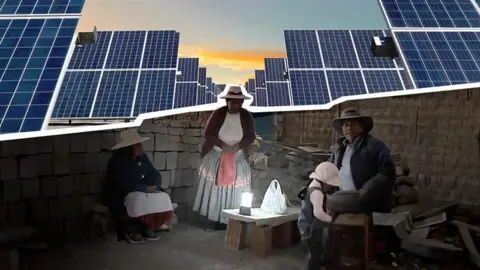The article titled “They Live Next to Peru’s Largest Solar Complex – So Why Are They Still in the Dark?” sheds light on a glaring irony faced by residents of Pampa Clemesí, a small settlement in southern Peru. Despite being situated adjacent to the Rubí solar power plant, which is part of the largest solar complex in Peru and one of the largest in Latin America, the people of Pampa Clemesí live without access to electricity.
The Rubí plant, which began operations between 2018 and 2024, boasts an impressive output of around 440 gigawatt-hours annually, enough to power 351,000 homes. Situated about 1,000 kilometers south of Lima, in the Moquegua region, the solar complex stands as a beacon of renewable energy potential, taking advantage of the area’s abundant sunshine—over 3,200 hours per year. However, the residents of Pampa Clemesí, which has around 150 inhabitants, remain disconnected from this energy bounty.
Residents, including Rosa Chamami, have taken to utilizing scraps from the solar plant to fuel their daily lives, with Rosa using cardboard leftovers from the 800,000 solar panels that once housed batteries and converters. The paradox intensifies as she observes the panels shining brightly just 600 meters away from her home, illuminating the area while her village remains cloaked in darkness.
Access to the national power grid has proven elusive for the residents of Pampa Clemesí. While some have received solar panels donated by the plant’s operator, Orygen, many lack the financial resources to purchase the accompanying batteries and converters required for functionality. As a result, at night, the villagers rely on torches or face the reality of living in the dark.
The broader context of electricity generation in Peru is promising, illustrated by a remarkable 96% growth in renewable electricity generation in 2024 alone. Yet, the disconnect between energy production and local accessibility reveals systemic failings. Carlos Gordillo, an energy specialist from the University of Santa María in Arequipa, asserts that the current energy system in Peru is designed primarily around profitability and has neglected the needs of sparsely populated areas.
Orygen maintains that it has fulfilled its obligations, having constructed power infrastructure intended to connect Pampa Clemesí to the larger grid. According to Marco Fragale, Orygen’s executive director in Peru, a dedicated power line with almost 4,000 meters of underground cable has been completed, and 53 power towers are ready for operation. However, the critical step of attaching these lines to individual homes has yet to occur, resting in the hands of the government, which has stalled in laying the necessary two kilometers of wiring.
The frustrations of the residents are palpable. Rosa, whose home lacks electrical sockets, ventures across the village daily seeking someone who can lend her a bit of power to charge her phone, an essential tool to connect with family residing near the Bolivia border. Among the few villagers with operational solar panels is Rubén Pongo, who can run a refrigerator for a limited time each day but still faces constraints due to cloudy weather.
The situation in Pampa Clemesí reflects a broader struggle for basic services. The village primarily constructed with discarded materials from the nearby solar plant, lacks essential infrastructure—no water system, no sewage, and no waste collection. Many residents have relocated due to these inadequacies, especially during the COVID-19 pandemic. Residents like Pedro Chará, now 70, express deep frustration and despair over the ongoing wait for electricity and water.
Dinners in the village occur under the dim glow of a solitary solar-powered torch, as residents eat simple meals with limited options for storage and preparation. Cooking often relies on firewood, a practice that poses health risks. As the darkness descends, communal dinners become a quiet ritual of survival, filled with a longing for light and connection.
Ultimately, the people of Pampa Clemesí illustrate the profound and tragic irony of living beside a renewable energy giant yet remaining in darkness. Their resilience in the face of such contradictions is marked by a persistent hope for change. As Rosa succinctly puts it, they endure not only because of the sun’s presence but because they hold onto the idea that one day, that brightness will shine within their homes as well.











